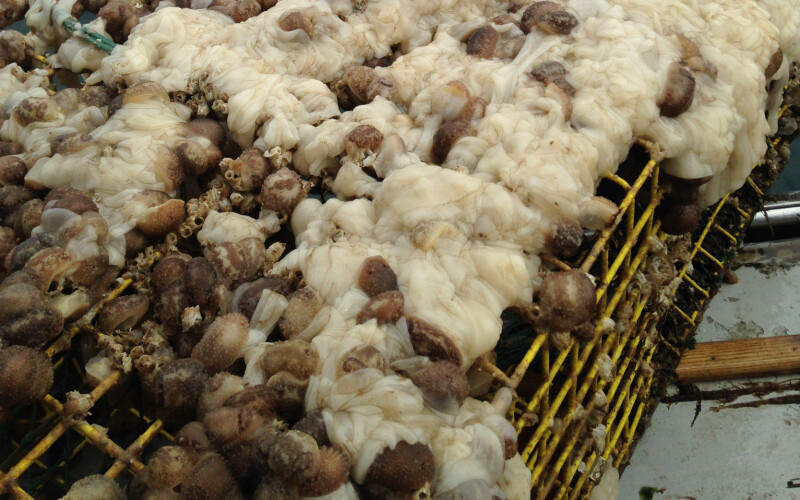Marine scientists say that sea squirts can be added to the list of invasive species that have been showing up in greater masses in the Gulf of Maine in recent years. Green crabs, black sea bass, sunfish, and red Asian seaweed are other unfamiliar species that have found a comfortable home in the warming waters along the coast.
Sea squirts are also known as tunicates, meaning they are mobile within their first few days of life but then attach themselves to pilings, rocks, or anything fixed in place. The species will find a home on the wire of lobster traps on the bottom that have laid there long enough without movement. They have become a nuisance for aquaculturists by taking over nets and underwater cages and smothering the oysters within.
There are hundreds of different kinds of sea squirts around the world. These types range from star tunicates to orange sheath tunicates to what are commonly called pancake batter tunicates. These types have developed a reputation as the messiest tunicate, as this batter-like species tends to make a mess of fishermen’s gear.
Tunicates are easily spread through the movement of gear, shellfish, and commercial and recreational boats. Coastal states and provinces within Canada are advised to regularly inspect and clean their boat hulls and equipment by letting them air dry for at least 48 hours. Those warnings are also relevant to fishermen in the Northeast, as the tunicates in the Gulf of Maine are creating similar problems.
An article from Maine Public states that sea squirts have migrated from overseas and become pervasive in recent years. The issues stem from how they compete with seaweed and other organisms for a habitat on the bottom. Frequently, they grow in bunches and then siphon water through their bodies as they extract the nutrients from the water. Sea squirts were not prevalent in the Damariscotta River in the early 1990s, but since the early 2000s have dominated much of the bottom.
Kevin Eckelbarger, former director of the University of Maine’s Darling Marine Center in South Bristol states, previously stated that while marine species populations fluctuate over time, invasive species have been known to cause sudden changes in some marine ecosystems by spreading diseases and out-competing native species. In the 2018 article, he stated that many of these sea squirts have been in Maine for over 100 years or more, having migrated across the ocean on ships.
An article from Mount Desert Islander shares that in some areas of Canada where scallop farming is common, there is a big problem with tunicates. Once the sea squirt settles onto the bags or crates underwater, it can cover the entire surface, preventing nutrients and water from reaching the shellfish inside. They have found that putting the gear at least 15 fathoms has prevented the sea squirts from furthering their growth and spread. This is due to the ocean temperatures and the lack of light. The colder the water, the more unhappy the species is.
Tunicates threaten lobster fishermen by weighing the traps down and covering the vents and wire that provide water flow to the species within. Because the traps give them a hard surface to thrive on, fishermen have been trying to detour these creatures from their gear. Diving further into this species since 2018, fishermen and scientists have found that the colder the winter, the better the chance to combat tunicates’ growth.
More significant issues related to the warming ocean temperatures and warmer winters have allowed sea squirts to feel right at home in previously inhabitable waters. Scientists warn that tunicates will change the coast in the Gulf of Maine and Canadian waters, compelling a close look at how this species is thriving and surviving in these ecosystems.







